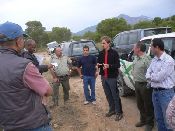|
Evaluating the desertification risk assessment tool with local experimental results |
 |
|
Author: Victor Jetten
Introduction
The hill slope areas near Eskişehir suffer from soil erosion. The area is semi-arid, soils are shallow, stony and organic matter content is low. Land use is rainfed wheat with occasional fallow periods. Slopes range from 10 to 20%. Late spring and early summer rainfalls are particularly erosive (400 mm annual rainfall with a marked dry season). Experiments were carried out that interrupt the runoff and help increase infiltration and thereby increasing soil moisture storage (wicker fences as sediment traps and contour ploughing). The overall objective is to decrease surface runoff and to reduce soil losses. Land abandonment in the area occurs because of urban migration.
Desertification indices
Desertification expresses itself as water erosion and possibly tillage erosion. Both get a rating of moderate with a rating of 2.82 and 2.91 respectively. The measures are difficult to implement. The wicker fences will cause terraces to be formed gradually. Implementing terraces only decreased the water erosion risk only slightly to 2.64.
Implementing a maximum interruption of runoff as a result of contour ploughing decreases water erosion risk to 2.66.
Implementing both terraces and contour ploughing decreases the erosion risk to low: 2.48.
 |
Wheat production on slopes without conservation measures
|
Conclusions
The general moderate water erosion risk is correct for the area where erosion is present but not excessive. The precise experimental measures (contour ploughing and wicker fences) could not be implemented but when translated to interruption of runoff and terracing give a small result. In reality the result was observed ones where the treated field had no erosion while the adjacent fuield did have erosion. Decreased runoff also expressed itself as a higher infiltration and increased water availability. This link is not made in the assessment tool (as it is built on correlation, not on process relations).
|




